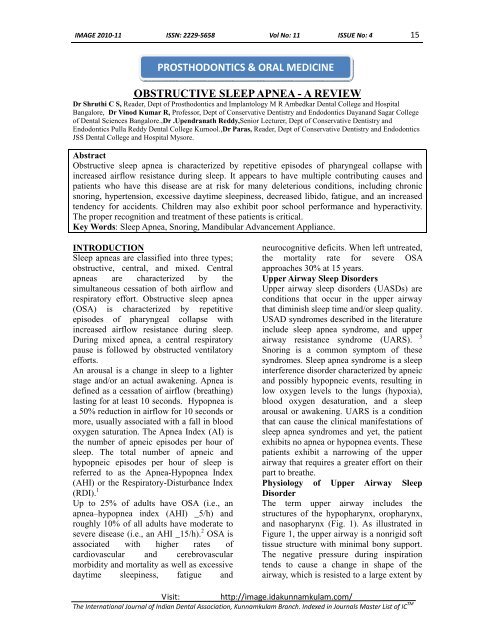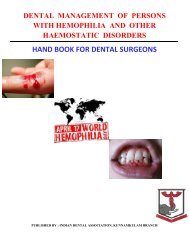'satisfactory smile' with a restorative approach - Indian Dental ...
'satisfactory smile' with a restorative approach - Indian Dental ...
'satisfactory smile' with a restorative approach - Indian Dental ...
You also want an ePaper? Increase the reach of your titles
YUMPU automatically turns print PDFs into web optimized ePapers that Google loves.
IMAGE 2010-11 ISSN: 2229-5658 Vol No: 11 ISSUE No: 4 15<br />
OBSTRUCTIVE SLEEP APNEA - A REVIEW<br />
Dr Shruthi C S, Reader, Dept of Prosthodontics and Implantology M R Ambedkar <strong>Dental</strong> College and Hospital<br />
Bangalore, Dr Vinod Kumar R, Professor, Dept of Conservative Dentistry and Endodontics Dayanand Sagar College<br />
of <strong>Dental</strong> Sciences Bangalore.,Dr .Upendranath Reddy,Senior Lecturer, Dept of Conservative Dentistry and<br />
Endodontics Pulla Reddy <strong>Dental</strong> College Kurnool.,Dr Paras, Reader, Dept of Conservative Dentistry and Endodontics<br />
JSS <strong>Dental</strong> College and Hospital Mysore.<br />
Abstract<br />
Obstructive sleep apnea is characterized by repetitive episodes of pharyngeal collapse <strong>with</strong><br />
increased airflow resistance during sleep. It appears to have multiple contributing causes and<br />
patients who have this disease are at risk for many deleterious conditions, including chronic<br />
snoring, hypertension, excessive daytime sleepiness, decreased libido, fatigue, and an increased<br />
tendency for accidents. Children may also exhibit poor school performance and hyperactivity.<br />
The proper recognition and treatment of these patients is critical.<br />
Key Words: Sleep Apnea, Snoring, Mandibular Advancement Appliance.<br />
INTRODUCTION<br />
Sleep apneas are classified into three types;<br />
obstructive, central, and mixed. Central<br />
apneas are characterized by the<br />
simultaneous cessation of both airflow and<br />
respiratory effort. Obstructive sleep apnea<br />
(OSA) is characterized by repetitive<br />
episodes of pharyngeal collapse <strong>with</strong><br />
increased airflow resistance during sleep.<br />
During mixed apnea, a central respiratory<br />
pause is followed by obstructed ventilatory<br />
efforts.<br />
An arousal is a change in sleep to a lighter<br />
stage and/or an actual awakening. Apnea is<br />
defined as a cessation of airflow (breathing)<br />
lasting for at least 10 seconds. Hypopnea is<br />
a 50% reduction in airflow for 10 seconds or<br />
more, usually associated <strong>with</strong> a fall in blood<br />
oxygen saturation. The Apnea Index (AI) is<br />
the number of apneic episodes per hour of<br />
sleep. The total number of apneic and<br />
hypopneic episodes per hour of sleep is<br />
referred to as the Apnea-Hypopnea Index<br />
(AHI) or the Respiratory-Disturbance Index<br />
(RDI). 1<br />
Up to 25% of adults have OSA (i.e., an<br />
apneañhypopnea index (AHI) _5/h) and<br />
roughly 10% of all adults have moderate to<br />
severe disease (i.e., an AHI _15/h). 2 OSA is<br />
associated <strong>with</strong> higher rates of<br />
cardiovascular and cerebrovascular<br />
morbidity and mortality as well as excessive<br />
daytime sleepiness, fatigue and<br />
PROSTHODONTICS & ORAL MEDICINE<br />
neurocognitive deficits. When left untreated,<br />
the mortality rate for severe OSA<br />
<strong>approach</strong>es 30% at 15 years.<br />
Upper Airway Sleep Disorders<br />
Upper airway sleep disorders (UASDs) are<br />
conditions that occur in the upper airway<br />
that diminish sleep time and/or sleep quality.<br />
USAD syndromes described in the literature<br />
include sleep apnea syndrome, and upper<br />
airway resistance syndrome (UARS). 3<br />
Snoring is a common symptom of these<br />
syndromes. Sleep apnea syndrome is a sleep<br />
interference disorder characterized by apneic<br />
and possibly hypopneic events, resulting in<br />
low oxygen levels to the lungs (hypoxia),<br />
blood oxygen desaturation, and a sleep<br />
arousal or awakening. UARS is a condition<br />
that can cause the clinical manifestations of<br />
sleep apnea syndromes and yet, the patient<br />
exhibits no apnea or hypopnea events. These<br />
patients exhibit a narrowing of the upper<br />
airway that requires a greater effort on their<br />
part to breathe.<br />
Physiology of Upper Airway Sleep<br />
Disorder<br />
The term upper airway includes the<br />
structures of the hypopharynx, oropharynx,<br />
and nasopharynx (Fig. 1). As illustrated in<br />
Figure 1, the upper airway is a nonrigid soft<br />
tissue structure <strong>with</strong> minimal bony support.<br />
The negative pressure during inspiration<br />
tends to cause a change in shape of the<br />
airway, which is resisted to a large extent by<br />
Visit: http://image.idakunnamkulam.com/<br />
The International Journal of <strong>Indian</strong> <strong>Dental</strong> Association, Kunnamkulam Branch. Indexed in Journals Master List of IC TM



